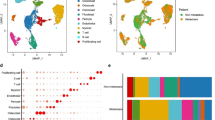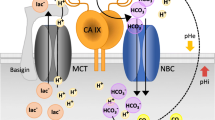Abstract
Production of heat shock protein 70 (HSP70/HSPA) is induced by a wide range of cellular stress conditions, such as cancer and hypoxia. This study investigated the level of HSPA gene expression in human cell lines exposed to hypoxic conditions. Three human glioma cell lines were selected for this study, each representing different types of glioma (astrocytoma, oligodendroglioma and glioblastoma), with a normal human astrocyte cell line used as a control. HSPA RNA transcripts and proteins were examined in these samples using qRT-PCR, immunofluorescence and flow cytometry techniques. The average HSPA mRNA copy numbers detected in three glioma cell lines were approximately sixfold higher than in a normal astrocyte cell line. The expression of HSPA was induced in normal cell lines immediately after exposure to hypoxia with 33 % of cells exhibiting expression. However, the effects of hypoxia on gene expression were marginal in glioma cells, due to the already increased levels of HSPA with both pre- and post-hypoxia samples showing expression in approximately 90 % of cells. These results show that whilst the stress caused by both cancer and hypoxia induce HSPA expression the underlying imprint of tumourgenesis leads to sustained expression.

Similar content being viewed by others
References
Graner MW, Raynes DA, Bigner DD, Guerriero V (2009) Heat shock protein 70-binding protein 1 is highly expressed in high-grade gliomas, interacts with multiple heat shock protein family members, and specifically binds tumour cell surfaces. Cancer Sci 10:1870–1879. doi:10.1111/j.1349-7006.2009.01269.x
Ciocca DR, Calderwood SK (2005) Heat shock proteins in cancer: diagnostic, prognostic, predictive, and treatment implications. Cell Stress Chaperones 10:86–103
Lindquist S, Craig EA (1988) The heat shock proteins. Annu Rev Genetics 22:631–677
Mosser DD, Morimoto RI (2004) Molecular chaperones and the stress of oncogenesis. Oncogene 23:2907–2918
Parsell A, Kowal AS, Singer KM, Lindquist S (1994) Protein disaggregation mediated by heat shock protein Hsp104. Nature 372:475–478
Oehler R, Schmierer B, Zellner M, Prohaska R, Roth E (2000) Endothelial cells downregulate expression of the 70 kDa heat shock protein during hypoxia. Biochem Biophys Res Com 274:542–547
Kang EH, Kim DJ, Lee EY, Lee YJ, Lee EB, Sons YW (2009) Downregulation of heat shock protein 70 protects rheumatoid arthritis fibroblast-like synoviocytes from nitric oxide-induced apoptosis. Arthritis Res Ther R130:1–8. doi:10.1186/ar2797
Lanneau D, de Thonel A, Maurel S, Didelot C, Garrido C (2007) Apoptosis versus cell differentiation: role of heat shock proteins HSP90, HSP70 and HSP70. Prion 1:53–60
Beckmann RP, Mizzen LE, Welch WJ (1990) Interaction of Hsp 70 with newly synthesized proteins: implications for protein `ing and assembly. Science 248:850–854
Seidberg NA, Clark RSB, Zhang X, Lai Y, Chen M, Grahams SH, Kochanek PM, Watkins SC, Marion DW (2003) Alterations in inducible 72-kDa heat shock protein and the chaperone cofactor BAG-1 in human brain after head injury. J Neurochem 84:514–521
Mayer MP, Bukau B (2005) Hsp70 chaperones: cellular functions and molecular mechanism. Cellular Mol Life Sci 62:670–684
Calderwood SK, Theriault JR, Gong J (2005) Message in a bottle: role of the 70-kDa heat shock protein family in anti-tumor immunity. Euro J Immunol 35:2518–2527
Santoro GM (2000) Heat shock factors and the control of the stress response. Biochem Pharmacol 59:55–63
Schmitt E, Gehrmann M, Brunet M, Multhoff G, Garrido C (2007) Intracellular and extracellular functions of heat shock proteins repercussions in cancer therapy. J Leukocyte Biol 8:15–27
Williams KJ, Cowen RL, Stratford IJ (2001) Hypoxia and oxidative stress in breast cancer Tumour hypoxia: therapeutic considerations. Breast Cancer Res 3:328–331
Bruick RK (2003) Oxygen sensing in the hypoxic response pathway: regulation of the hypoxia-inducible transcription factor. Genes Dev 17:2614–2623
Duffy JP, Eibl G, Reber HA, Hines OJ (2003) Influence of hypoxia and neoangiogenesis on the growth of pancreatic cancer. Mol Cancer 2:2–12
Nylandsted J, Brand K, Jaattela M (2000) Heat shock protein 70 is required for the survival of cancer cells. Ann N Y Acad Sci 926:122–125
Ciocca DR, Rozados VR, Carrion FDC, Gervasoni SI, Matar P, Scharovsky OG (2003) Hsp25 and Hsp70 in rodent tumors treated with doxorubicin and lovastatin. Cell Stress Chaperones 8:26–36
Rohde M, Daugaard M, Jensen MH, Helin K, Nylandsted J, Jaattela M (2005) Members of the heat-shock protein 70 family promote cancer cell growth by distinct mechanisms. Genes Dev 19:570–582
Kay HH, Zhu S, Tsoi S (2007) Hypoxia and lactate production in trophoblast cells. Placenta 28:854–860
Patel R, Shervington L, Lea R, Shervington A (2008) Epigenetic silencing of telomerase and a non-alkylating agent as a novel therapeutic approach for glioma. Brain Res 1188:173–181
Shervington A, Lu C, Patel R, Shervington L (2009) Telomerase down-regulation in cancer brain stem cell. Mol Cell Biochem 331:153–159
Patel B, Khaliq A, Jarvis-Evans J, Boulton M, Arrol S, Mackness M, McLeod D (1995) Hypoxia induces HSP70 gene expression in human hepatoma (HEP G2) cells. Biochem Mol Biol Int 36:907–912
Turman MA, Kahn DA, Rosenfeld SL, Apple CA, Bates CM (1997) Characterization of human proximal tubular cells after hypoxic preconditioning: constitutive and hypoxia-induced expression of heat shock proteins HSP70 (A < B, and C), HSC70 and HSP90. Biochem Mol Med 60:49–58
Syrigos KN, Harrington KJ, Sekara E, Chatziyianni E, Syrigou EI, Waxman J (2003) Clinical significance of heat shock protein-70 expression in bladder cancer. Urology 61:677–680
Piura B, Rabinovich A, Yavelsky V, Wolfson M (2002) Heat shock proteins and malignancies of the female genital tract. Harefuah 141:962–972
Thanner F, Sutterlin MW, Kapp M, Kristen P, Dietl J, Gassel AM, Muller T (2003) Heat-shock protein 70 as a prognostic marker in node-negative breast cancer. Anticancer Res 23:1057–1062
Ricaniadis N, Kataki A, Agnantis N, Androulakis G, Karakousis CP (2001) Long-term prognostic significance of HSP70, c-myc and HLA-DR expression in patients with malignant melanoma. Euro J Surgical Oncol 27:88–93
Santarosa M, Favaro D, Quaia M, Galligioni E (1997) Expression of heat shock protein 72 in renal cell carcinoma: possible role and prognostic implications in cancer patients. Euro J Cancer 33:873–877
Sagol O, Tuna B, Coker A (2002) Immunohistochemical detection of pS2 protein and heat shock protein-70 in pancreatic adenocarcinomas. Relationship with disease extend and patient survival. Pathol Res Prac 198:77–84
Lebret T, William R, Watson G, Molinie V, O’Neill A, Gabrial C, Fitzpatrick JM, Botto H (2003) Heat shock proteins HSP27, HSP60, HSP70 and HSP90. Am Cancer Soc 98:970–977
Ciocca DR, Clark GM, Tandon AK, Fuqua SAW, Welch MJ, McGuire WL (1993) Heat shock protein hsp70 in patients with axillary lymph node-negative breast cancer: prognostic implications. J Natl Cancer Inst 85:570–574
Soussi T, Lozano G (2005) p53 mutation heterogeneity in cancer. Biochem Biophys Res Com 331:834–842
Powers MV, Clarke PA, Workman P (2009) Death by chaperone: HSP90, HSP70 or both? Cell Cycle 8:518–526
Author information
Authors and Affiliations
Corresponding author
Rights and permissions
About this article
Cite this article
Beaman, G.M., Phoenix, D.A., Dennison, S.R. et al. Investigation into the potential for hypoxic interior of neoplasms to enhance HSPA expression in glioma. Mol Cell Biochem 394, 53–58 (2014). https://doi.org/10.1007/s11010-014-2080-9
Received:
Accepted:
Published:
Issue Date:
DOI: https://doi.org/10.1007/s11010-014-2080-9




